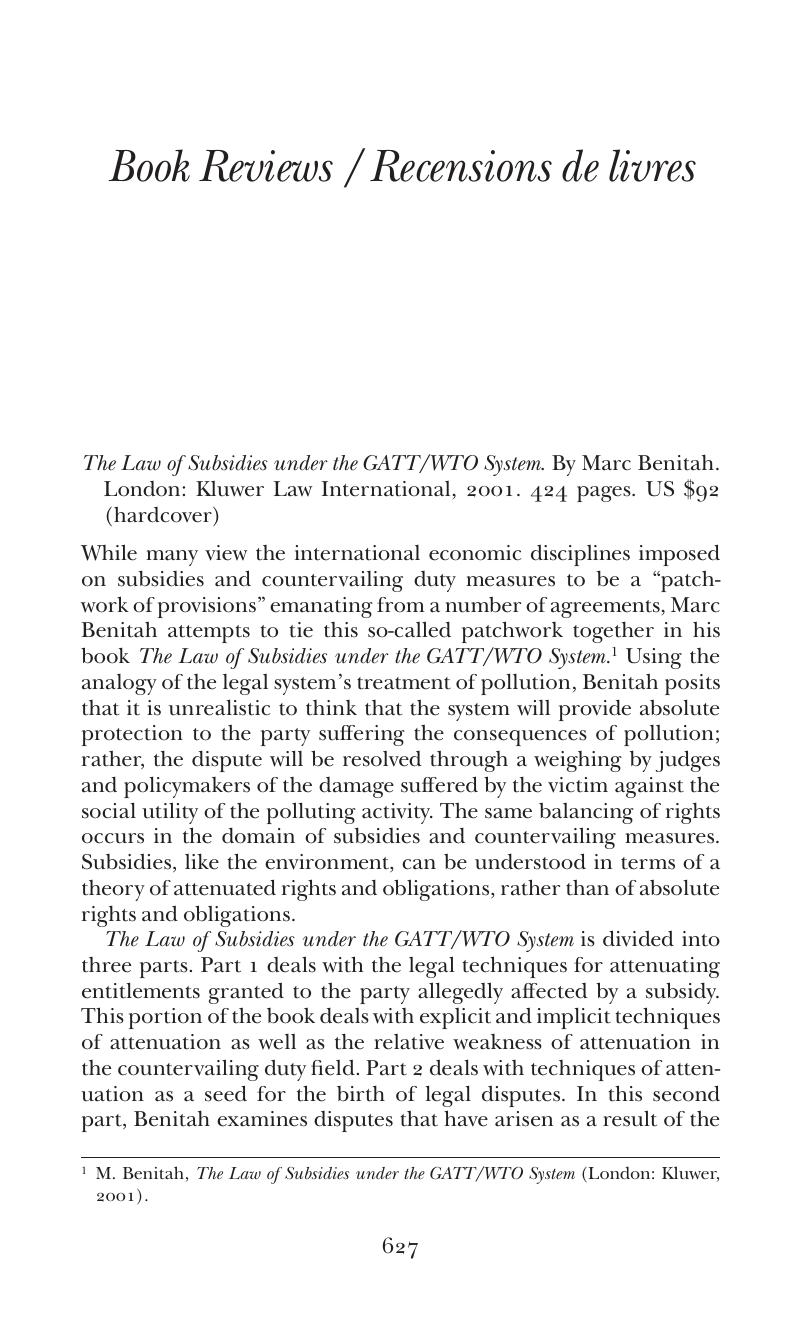No CrossRef data available.
Published online by Cambridge University Press: 09 March 2016

1 Benitah, M., The Law of Subsidies under the GATT/WTO System (London: Kluwer, 2001).Google Scholar
2 General Agreement on Tariffs and Trade, April 15, 1994, WTO Agreement, Annex i A of the Marrakesh Agreement Establishing the World Trade Organiza-tion [hereinafter WTO Agreement], 33 ILM 1226 (1994).
3 US Tariff Act, 19 U.S.C. 1202–1527, 46 Stat. 741.
4 Japan – Measures Affecting Imports of Pork, January 31, 2001, WTO Doc. WT/ DS66/2.
5 Benitah, supra note 1 at 211
6 Subsidies and Countervailing Measures Agreement, Annex 1A of the WTO Agreement, supra note 2 [hereinafter SCM Agreement].
7 Benitah, supra note 1 at 90.
8 This is exactly how Article 14 (d) of the SCM Agreement, supra note 6, has been interpreted in the United States — Preliminary Determinations with Respect to Certain Softwood Lumber from Canada, September 27, 2002, WTO Doc. WT/DS 236/R at 7.49–7.58. A similar argument is being considered by the WTO in United States — Final Countervailing Duty Determination with Respect to Softwood Lumber from Canada, 2002, WTO Doc. WT 257 [hereinafter Softwood Lumber case].
9 SCM Agreement, supra note 6, Article 15.5 provides that “[i]t must be demonstrated that the subsidized imports are, through the effects 47 of subsidies, caus-ing injury within the meaning of this Agreement.”
Footnote 47 states: “As set forth in paragraphs 2 and 4” Articles 15.2 and 15.4 discuss injury factors (that is, impact on price, quantity). Articles 15.1 and 15.2 provide in relevant part:
A determination of injury & shall be based on positive evidence and involve an objective examination of both (a) the volume of the subsidized imports and the effect of the subsidized imports on prices in the domestic market for like products and (b) the consequent impact of these imports on the domestic producers of such products.
With regard to the volume of the subsidized imports, the investigating authorities shall consider whether there has been a significant increase in subsidized imports, either in absolute terms or relative to production or consumption in the importing Member.
10 A similar argument is currently being made before a North American Free Trade Agreement panel in the ongoing Softwood Lumber litigation, supra note 8. In Softwood Lumber, it has been alleged that the International Trade Commission unlawfully disregarded a study submitted by the Canadian industry demonstrating that the domestic and export prices of softwood lumber are either unaffected by or in fact raised by the current system of stumpage in provincial forests and that the domestic production and exports of softwood lumber are either unaffected by or lowered by stumpage. This argument is in accordance with Benitah’s “sophisticated” view of distortion.
11 Benitah, supra note 1 at 342
12 United States -Preliminary Determinations with Respect to Certain Softwood Lumber from Canada, September 27, 2002, WTO Doc. WT-DS236/R. The interim report in United States – Final Countervailing Duty Determination with Respect to Certain Softwood Lumber from Canada is expected on May 20, 2003.
13 Canada — Measures Affecting the Importation of Milk and the Exportation of Dairy Products, December 20, 2002, WTO Doc. WT/DS103/30.
14 See office of the United States Trade Representative, “U.S. & Canada Reach Agreement Ending Legally Subsidized Canadian Dairy Exports to U.S.,” May 9, 2003.